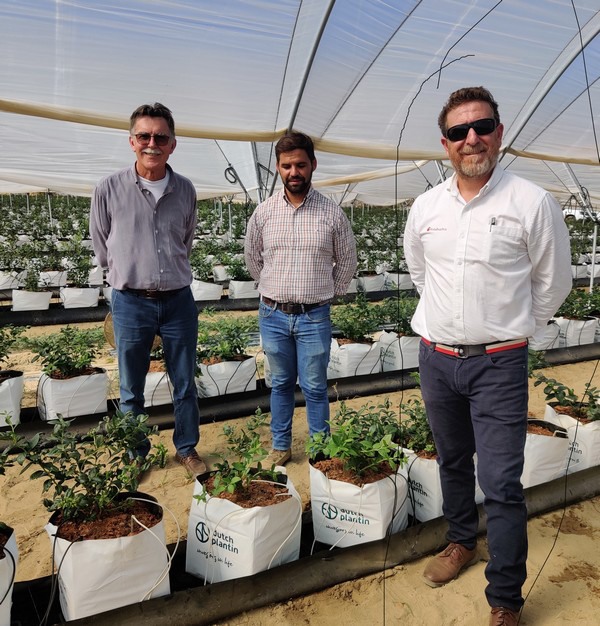The cultivation of berries in Huelva is a contemporary success story. The production of Huelva's strawberries, which started developing as a pioneering project between the late '50s and early '60s of the 20th century, has allowed Spain to become the largest producer of this fruit in the European Union, although the true magnitude of this industry in Huelva is evident when looking at the figures it yields. It accounts for almost 97% of Spain's total harvest, and for approximately 23.8% of the production of this fruit in the EU-27 in the 2020/21 campaign, according to Eurostat data, placing it well ahead of the next largest EU producers, Poland and Germany, with shares of 16.3% and 13.8%, respectively.
Blueberries, which were introduced even more recently in Huelva, have followed in the steps of strawberries in their relatively few decades of history. In 2020, Huelva's blueberries, which accounted for 93.9% of the Spanish production, turned Spain into the fruit's largest producer in the EU-27, with the province accounting for a share of close to 33.4%, far ahead of the next largest EU producers Poland and Portugal.
Blueberries have expanded quickly in recent years in Huelva: in the last five campaigns alone, the acreage has increased by more than 130%. Both the growing demand and the new cultivation techniques, such as hydroponics, have contributed to their adoption by consolidated companies, such as Perla Huelva, which has been growing strawberries for more than 20 years.
"For now, we only have 2 hectares in production, but we hope to grow to 7 hectares in the next 2 years. From the very start, we have been producing with hydroponic cultivation in 30-liter bags of coconut fiber substrate with a planting density of 9,200 plants per hectare. Hydroponic cultivation allows the tree to start producing earlier and, by having more plants per unit area, yields per hectare are also higher," says Juan Ramón Hernández, general manager of the company based in Rociana del Condado.

Juan Ramón Hernández at the blueberry plantation of Perla Huelva.
"Cultivation in coconut substrate, which is supplied to us by the Dutch company Dutch Plantin, had already been tested with strawberries and raspberries, and the difference compared to cultivation in soil is very significant. Berries are very sensitive to soil moisture and the substrate allows us to control this factor perfectly. With the help of technology, like various types of sensors, or microtensiometers, the right humidity values can be controlled at all times, so that irrigation is only applied when the plant really needs it," says Juan Ramón.
"Not only does it save water, only the right amount is used. Hydroponic cultivation allows us to use this limited resource as efficiently as possible," he says. "The next step will be the recirculation of drainage water. In soil cultivation, the water that drains away ends up in aquifers, but in the very short term, we will have the technology allowing us to reuse the drainage water from hydroponic crops as many times as possible. Sustainability is essential, and today there is no future not only for non-sustainable agriculture, but also for non-sustainable societies as a whole."
"The same goes for fertilization, which is done on demand and allows the process to be optimized. It also facilitates crop management and allows things that are unthinkable in soil production. For example, raspberry plants can be moved and placed in cold storage, which in turn makes it possible to advance the production, and in the case of blueberries, plants can be produced in high density and, as the trees grow, they can be redistributed, advancing the production in a smaller area," says the berry industry professional.
"Another advantage of hydroponic growing is that it makes the job of pickers easier by allowing them to be in a more ergonomic position when harvesting, and this makes it easier to attract labor for picking. In fact, having our strawberries grown hydroponically at some height has given us a competitive advantage in hiring labor over other colleagues who grow them in the ground," says Juan Ramón.
Is hydroponics the future of blueberry production in Huelva?
The advantages of hydroponics in the cultivation of berries are not only explicable but visible in the agricultural landscape of the province. When traveling the roads of some counties, you see more and more blueberry crops in pots, strawberries in sacks, or raspberries in trays.
"The growth of hydroponics is exponential and the gap between it and traditional cultivation is being bridged by leaps and bounds," says Juan Ramon. "I would not say that hydroponics will completely displace soil cultivation in the future, because in Huelva we have very good sandy soils that yield very similar results to hydroponics, but I believe that the leading companies will grow much of their production on hydroponic cultivation. Agriculture is moving towards technologization and digitalization and, just as it happened when tractors arrived 60-70 years ago, those who fail to adapt will be left behind. This is what is happening now with the use of technology in agriculture, efficient irrigation, the optimization of water and nutrients, or new cultivation techniques," he says.
Notwithstanding their production method, blueberries, as well as other berries from Huelva, will continue to be foods with a high functional value. As Juan Ramón recalls, strawberries contain more vitamin C than oranges, and blueberries are a great source of antioxidants and are healthy snacks that are easy to transport and consume anytime and anywhere. These factors explain the increase in their demand and, in the case of blueberries, the significant growth in their per capita consumption in recent years which is expected to continue in all EU countries. "Most of our production is intended for export to Europe, although we are increasingly working more with the domestic market. Little by little, we are also seeing consumption increase in Spain," says Juan Ramón.
 For more information:
For more information:
Juan Ramón Hernández Pérez
General Director
Perlahuelva Fruits Export S.L.
Calle Zalema, 14
21720 Rociana del Condado, Huelva, Spain
Tel.: +34 610 728 319
perlahuelva@perlahuelva.com
https://perlahuelva.com
